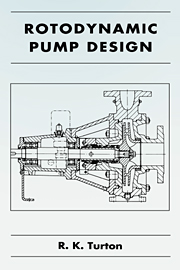Book contents
- Frontmatter
- Contents
- Preface
- Symbols
- 1 Fundamental principles
- 2 Cavitation in pumps
- 3 Centrifugal pump principles
- 4 Principles of axial and mixed flow pumps
- 5 Flow calculations in pumps and an introduction to computer aided techniques
- 6 Single stage centrifugal pump design
- 7 The design of axial and mixed flow pumps
- 8 Basic design principles of shafts, bearings and seals, and selection of drive
- 9 Pump design for difficult applications
- 10 An introduction to the next stage in the pump design process
- References
- Index
7 - The design of axial and mixed flow pumps
Published online by Cambridge University Press: 29 September 2009
- Frontmatter
- Contents
- Preface
- Symbols
- 1 Fundamental principles
- 2 Cavitation in pumps
- 3 Centrifugal pump principles
- 4 Principles of axial and mixed flow pumps
- 5 Flow calculations in pumps and an introduction to computer aided techniques
- 6 Single stage centrifugal pump design
- 7 The design of axial and mixed flow pumps
- 8 Basic design principles of shafts, bearings and seals, and selection of drive
- 9 Pump design for difficult applications
- 10 An introduction to the next stage in the pump design process
- References
- Index
Summary
Introduction
Axial and mixed flow pumps will be treated as members of the same family, as they are high specific speed machines, even though the ‘Francis’ type of centrifugal machine has a mixed flow path. Both types exhibit the same characteristic behaviour, with a rise of specific energy towards shut valve which can be high in axials and in some mixed flow machines, and share a distinct tendency to unstable behaviour at part flow, and a power requirement which rises as flow reduces.
Energy is imparted to the fluid by blades rather than passages, and instability arises from flow breakdown over the blade profiles (giving rise to stall effects as described in Chapter 4). The interaction of fluid and pump components is complex, and performance is affected by blade profiles, surface finish, small variations in blade spacing and setting, and intake disturbances.
The principles underlying isolated blade profiles and blades in close proximity were described in Chapter 4, and simple but reasonably effective design techniques can be applied to the axial flow pump when the inlet flow is undisturbed. Quite efficient machines have been designed in the empirical way outlined in Section 7.3, but higher performance axial machines and all mixed flow machines require more sophisticated approaches, discussed in Section 7.4. Computer based methods were discussed in outline in Chapter 5.
- Type
- Chapter
- Information
- Rotodynamic Pump Design , pp. 124 - 139Publisher: Cambridge University PressPrint publication year: 1994

